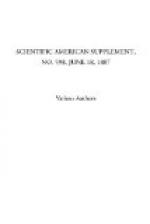Mr. White said that as soon as it was found that with twin screws they lost nothing in efficiency, ship owners generally were contemplating their adoption, an admirable example of which had been set in the vessels of the Hill line. In adopting twin screws, the question whether they should overlap was one that deserved very serious consideration, and it was interesting to know, from experience gained by the vessels of the Hill line, that there was no difficulty in the way of the projection of the screws. With a moderate power, and with vessels of considerable size, the screws were well sheltered: but in the large ships which were contemplated, where there must necessarily be larger screws, this might be different, and become a difficulty.
Mr. Linnington, in reply, said there was no reason to think that the twin screw at sea might not be as satisfactory, in comparison with the single screw, as it appeared in smooth water. As a matter of fact, one of the great advantages of twin screws was that at sea the condition of weather which would bring the single screw out of the water, and make it extremely inefficient, would have no appreciable effect on the twin screws. In vessels of deep draught especially, they were well immersed, and they were really more efficient at sea than in smooth water. In ships of full form, the longitudinal position of the screws was of importance; but in the ships referred to in this table the run was very fine, and the screws were well covered by the hull. He did not think, in such a case, any small difference in longitudinal position would affect the performance. If any alteration were made, it would probably be better to put the screws farther off. When the rudder was hard over, the blades of the screw should be about a foot clear of the rudder.—Industries.
* * * * *
RECENT ADVANCES IN SEWING MACHINERY.
[Footnote: A recent lecture before the Society of Arts, London.]
By John W. Urquhart.
The distinct improvements in sewing machinery to which I would invite your attention this evening have reference more particularly to the results of inventive effort within the past ten years. But although marked development in the machines has occurred in so short a time, it may be taken for granted that those advances are but the accumulated results of many years’ prior invention and experience of stitching appliances.
The history of the sewing machine, and the decision of the great question, Who invented an apparatus that would unite fabrics by stitches? do not at present concern us. Many sources of information are open to those who would decide that extremely involved problem. But whether the production of the first device of this kind be claimed for England or for America, it is quite certain that no one man invented the perfect machine, and that those fine specimens of sewing apparatus shown here to-night embody the labors of many earnest workers, both in Europe and America.




